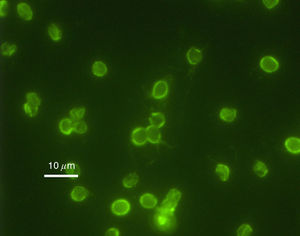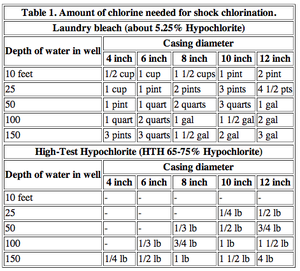Shock chlorination
Introduction
From swimming pools to wells, chlorine is a common chemical used to disinfect water sources.
Due to safety concerns, hypochlorite (bleach) is the most commonly used compound to conduct shock chlorination1. Hypochlorite is used in one of three forms: commercial bleach (approx. 3.5-5% concentration), calcium hypochlorite (Ca(OCl)2; 65-70% concentrated), or sodium hypochlorite (NaOCl; about 12% concentration)2. These forms of hypochlorite are not as pure as chlorine gas, and will degrade in strength when in storage. However, like chlorine gas, they also react with water to form a disinfectant, hypochlorous acid (HOCl).
Microbial agents
Frequently, microbial factors infiltrate water sources through fecal matter. Many types of bacterial pathogens can initiate waterborne illnesses, including enteric bacteria, protozoa, or viruses3.
Due to the variety of species that can inhabit water sources, it comes as no surprise that chlorine has varying affects on the types of microbes. Though time and concentration can eliminate virtually every species, some species remain resistant to the process. Species such as Vibrio cholera have been tested to last approximately 30 days in drinking water sources, while toxigenic E.coli can last 90 days4. Survival techniques include cysts, spores, absorption, and intracellular survival and growth. Other species will remain viable, but no longer culturable.
Helicobacter pylori

Helicobacter pylori is known to cause gastritis and peptic ulcers.
Studies done in Peru5 and Japan6 have shown the presence of the bacteria in public water sources, proving its possibility as a waterborne microbe.
Cryptosporidium

Cryptosporidium parvum is a type of parasite capable of causing gastrointestinal illness. Unlike Helicobacter pylori, however, Cryptosporidium has been proven to be unresponsive to most chlorination7.
In 1993, Milwaukee (Wisconsin) experienced one of the worst waterborne outbreaks after one of the city's water plants failed to remove Cryptosporidium oocysts from the Lake Michigan water collected for public use. Over 403,000 residents and visitors were affected, experiencing the watery diarrhea, nausea, fever, vomiting, and abdominal cramps associated with infection. Approximately 54 deaths occurred, although there is some debate regarding other preexisting conditions that affected patient survival8
In October 2013, a resurgence of the Cryptosporidium protozoan appeared in Milwaukee, this time in local swimming pools.
Methods
Commercial
Domestic

Success rates
Alternative methods
Scientists are not content with shock chlorination. As technology advances, methods to improve both testing and disinfection are created.
References
Edited by Erika Jensen, student of Joan Slonczewski for BIOL 116 Information in Living Systems, 2013, Kenyon College.
